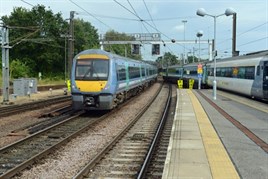The Great Eastern market operates within the southern and eastern region of the EA franchise. Destinations include Southend, Southminster, Clacton-on-Sea, Ipswich, Clacton, Colchester, Braintree (via Witham), Harwich and Walton-on-the-Naze (via Thorpe-le-Soken) to London Liverpool Street and Sudbury (the latter operates via a connection at Marks Tey).
Here again, revenue growth has not been great - it averaged 4.6% over the seven years to 2013, below the average London and South East revenue growth of 7.4% over the same period.
By far the most popular journey is Chelmsford to London, both for overall journeys per day and for season tickets. Most destinations have one train per hour, although Southminster has two, Clacton three and Southend six. Chelmsford has two, but that is a through station while the others are termini.
The West Anglia market covers London to Hertford, Cambridge and Kings Lynn, but not Stansted Airport. This offers an alternative to Govia Thameslink Railway, although at an average journey time of 85 minutes it is much slower than the GTR journey time average of 54 minutes between Cambridge and London.
More than half of those travelling on the WA route are season ticket holders commuting into London. Cheshunt-London is the biggest flow, followed by Broxbourne-London.
Stansted Express is ‘separate’ from the rest of the East Anglia service provision, with its own dedicated fleet, brand, website, on board catering provision and marketing. However, unlike services such as Heathrow Express, it is not a direct fast airport service.
Trains run four times an hour, with a typical journey from London Liverpool Street to Stansted Airport taking between 45 and 49 minutes, depending on the stopping pattern. All trains stop at Tottenham Hale for connections onto the Victoria Line, with an additional stop at either Harlow Town or Bishops Stortford and one train per hour stopping at Stansted Mountfitchet.
On weekday peaks, further additional calls are made at Sawbridgeworth, Enfield Lock, Waltham Cross and Brimsdown (maximum six calls per train), to accommodate London commuting demand. This extends the journey time up to 57 minutes and results in many of the peak-time Stansted Express services being crowded with commuters rather than airport users.
It is the second highest yielding service group on the EA franchise, with an average fare of £11 excluding the other WA services. But its greatest competition is roads - a Peak Return ticket is £38.40 for a 45-minute train journey, compared with a £15 Peak Return by coach from Victoria using Terravision, which takes 75 minutes.
This competition has been mirrored in the decline of the rail market share to the airport. The coach market share has risen from 21% to 29%, while rail has dropped to 22%. Overall, 49% of airport users arrived by car.
The EA franchise is also required to provide a significant regional service. The top two journeys are Cambridge to Ely and Great Yarmouth to Norwich.
Regional services with the lowest demand also have some of the lowest ticket yields on the EA route, at less than £3. It is also highlighted that many of these regional services cross the Felixstowe-Nuneaton freight corridor, which represents a challenge for timetable planning and line regulation.
There are also seven stations served by a skeleton service pattern on the regional services. These are: Berney Arms (three trains per day with four on Sundays); Spooner Row (three trains per day); Eccles Road and Harling Road (two trains per day); Shippea Hill (one train per day); and Buckenham and Lakenheath (Saturday and Sunday only).
Importantly, from May 31 2015 the current Abellio Greater Anglia franchise loses part of its existing operations. Twelve stations will transfer to Crossrail when it takes over the Metro services between Liverpool Street and Shenfield. Forty-four Class 315 electric multiple units, 122 station staff, 92 drivers and four cleaners also move to Crossrail from that date.
On the same day, Transport for London takes over West Anglia Inner services, which will move to London Overground. This involves 24 stations, 17 Class 315s, eight ‘317/7s’ and seven ‘317/8s’ moving to LO. The numbers of staff transferring were not known at the date of publication, but will be made available once pre-qualified bidders are announced.
Currently AGA employs 3,008 staff and operates some 1,900 trains on weekdays, 1,600 on Saturdays and 800 on Sundays. There are 354,000 journeys made per day and 135.2 million per year. AGA currently has 176 stations.
















Login to comment
Comments
No comments have been made yet.